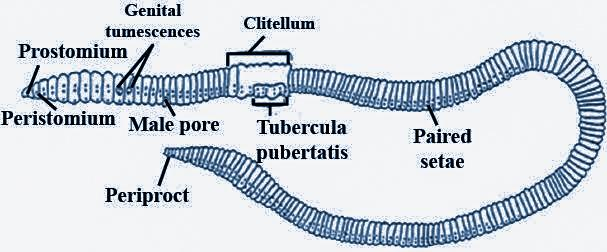Answer
408.6k+ views
Hint: This is the non-segmented section located near the anterior end of the body of earthworm.
Complete answer:
Earthworms are terrestrial invertebrates belonging to the class clitellata of phylum Annelida. They are commonly found in soil and they consume a wide variety of organic matter, such as living protozoa, rotifers, plant matter, nematodes, bacteria, fungi and other microorganisms. Their body is externally segmented with corresponding internal segmentation.
The clitellum is part of the reproductive system of earthworms. It is a thick saddle-like ring found in the epidermis (skin) of the worm. It is a non-segmented glandular section near the head at the anterior end of the body. It secretes a viscid sac where eggs are stored. It is particularly located between the fourteenth and seventeenth segments of the body.

Additional Information:
> The clitellum can only be seen in the sexually mature worms and used in sexual reproduction of some annelids.
> It may be white, reddish-brown or orange-red in colour. When the clitellum is orange it means the earthworm is ready to mate.
> Clitellum secretes a viscous fluid to form a cocoon for its eggs.
> The alimentary canal of the earthworm consists of mouth and buccal cavity (running through the first one or two segments), pharynx (running about four segments in length), oesophagus, crop, gizzard and intestine.
> Except for the mouth and the anal segments, each segment carries setae and nephridia.
So, the correct answer is option (B) 14, 15, 16 segments.
Notes:
- Gizzard uses stones eaten by earthworms to grind the food completely.
- Setae are bristles like hairs used to anchor parts of the body during movement.
- Nephridia is found in pairs and removes metabolic waste from the body. It performs a function similar to vertebrate kidneys.
Complete answer:
Earthworms are terrestrial invertebrates belonging to the class clitellata of phylum Annelida. They are commonly found in soil and they consume a wide variety of organic matter, such as living protozoa, rotifers, plant matter, nematodes, bacteria, fungi and other microorganisms. Their body is externally segmented with corresponding internal segmentation.
The clitellum is part of the reproductive system of earthworms. It is a thick saddle-like ring found in the epidermis (skin) of the worm. It is a non-segmented glandular section near the head at the anterior end of the body. It secretes a viscid sac where eggs are stored. It is particularly located between the fourteenth and seventeenth segments of the body.

Additional Information:
> The clitellum can only be seen in the sexually mature worms and used in sexual reproduction of some annelids.
> It may be white, reddish-brown or orange-red in colour. When the clitellum is orange it means the earthworm is ready to mate.
> Clitellum secretes a viscous fluid to form a cocoon for its eggs.
> The alimentary canal of the earthworm consists of mouth and buccal cavity (running through the first one or two segments), pharynx (running about four segments in length), oesophagus, crop, gizzard and intestine.
> Except for the mouth and the anal segments, each segment carries setae and nephridia.
So, the correct answer is option (B) 14, 15, 16 segments.
Notes:
- Gizzard uses stones eaten by earthworms to grind the food completely.
- Setae are bristles like hairs used to anchor parts of the body during movement.
- Nephridia is found in pairs and removes metabolic waste from the body. It performs a function similar to vertebrate kidneys.
Recently Updated Pages
How do you arrange NH4 + BF3 H2O C2H2 in increasing class 11 chemistry CBSE

Is H mCT and q mCT the same thing If so which is more class 11 chemistry CBSE

What are the possible quantum number for the last outermost class 11 chemistry CBSE

Is C2 paramagnetic or diamagnetic class 11 chemistry CBSE

What happens when entropy reaches maximum class 11 chemistry JEE_Main

Calculate the volume occupied by 88 gram of CO2 at class 11 chemistry CBSE

Trending doubts
Difference between Prokaryotic cell and Eukaryotic class 11 biology CBSE

Difference Between Plant Cell and Animal Cell

Fill the blanks with the suitable prepositions 1 The class 9 english CBSE

Change the following sentences into negative and interrogative class 10 english CBSE

Give 10 examples for herbs , shrubs , climbers , creepers

What organs are located on the left side of your body class 11 biology CBSE

Write an application to the principal requesting five class 10 english CBSE

What is the type of food and mode of feeding of the class 11 biology CBSE

Name 10 Living and Non living things class 9 biology CBSE



